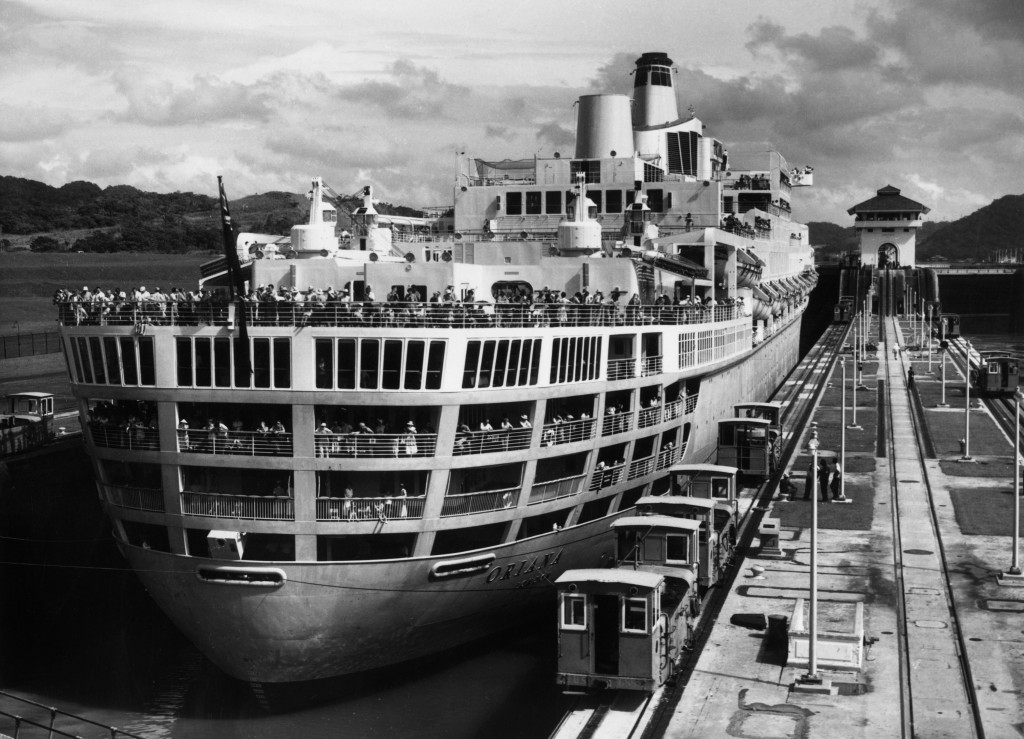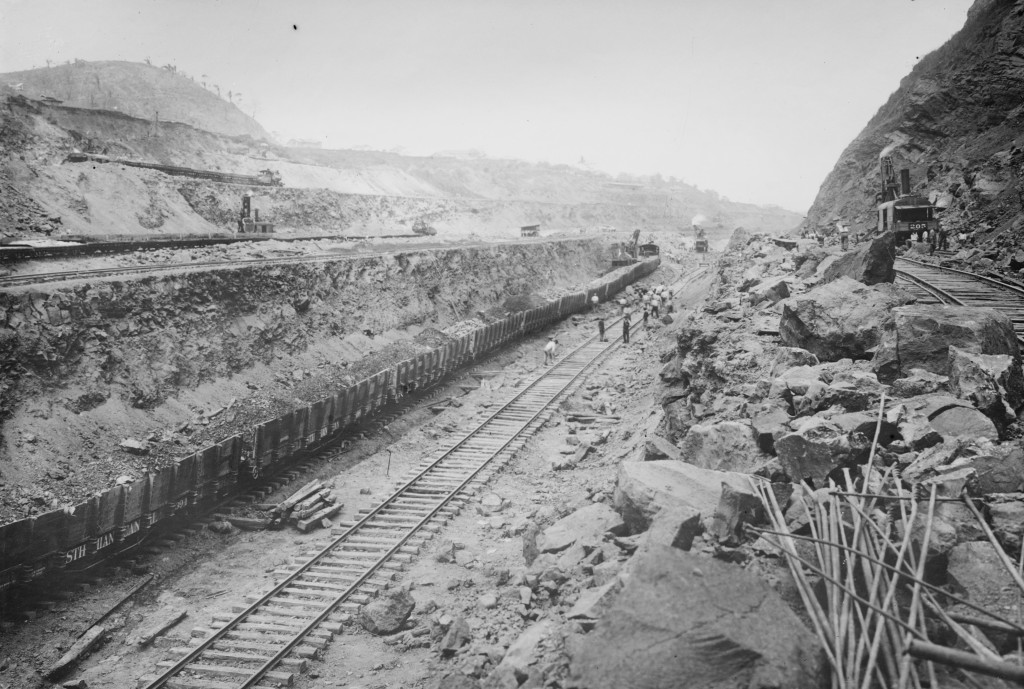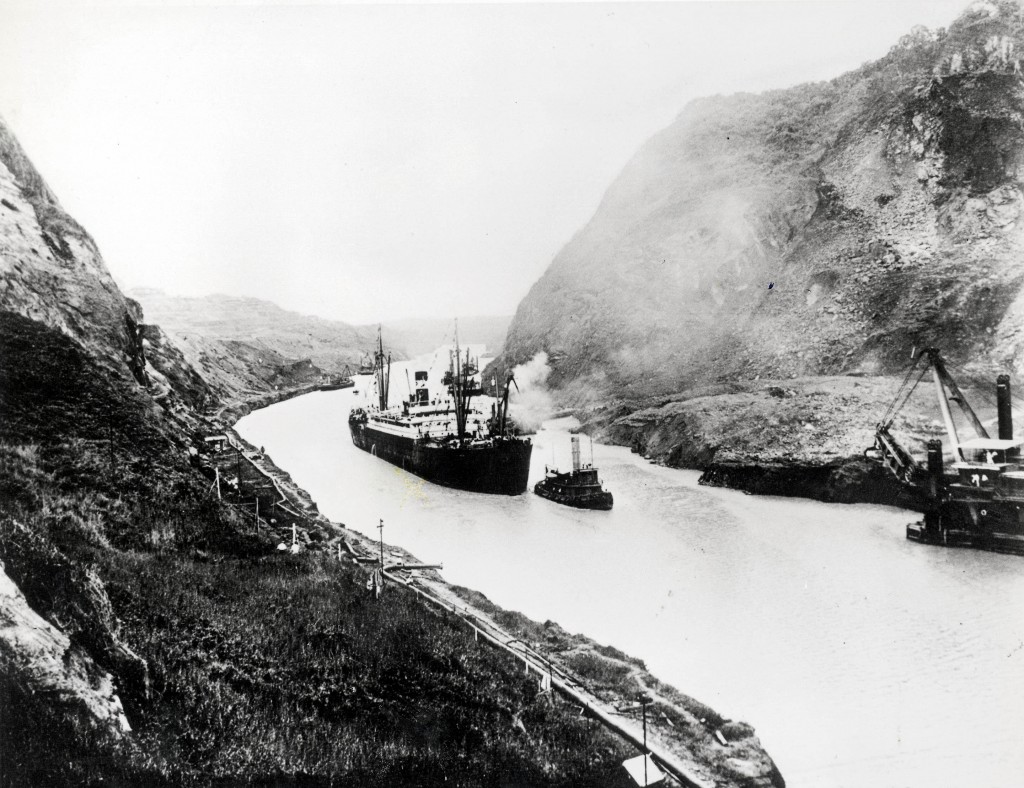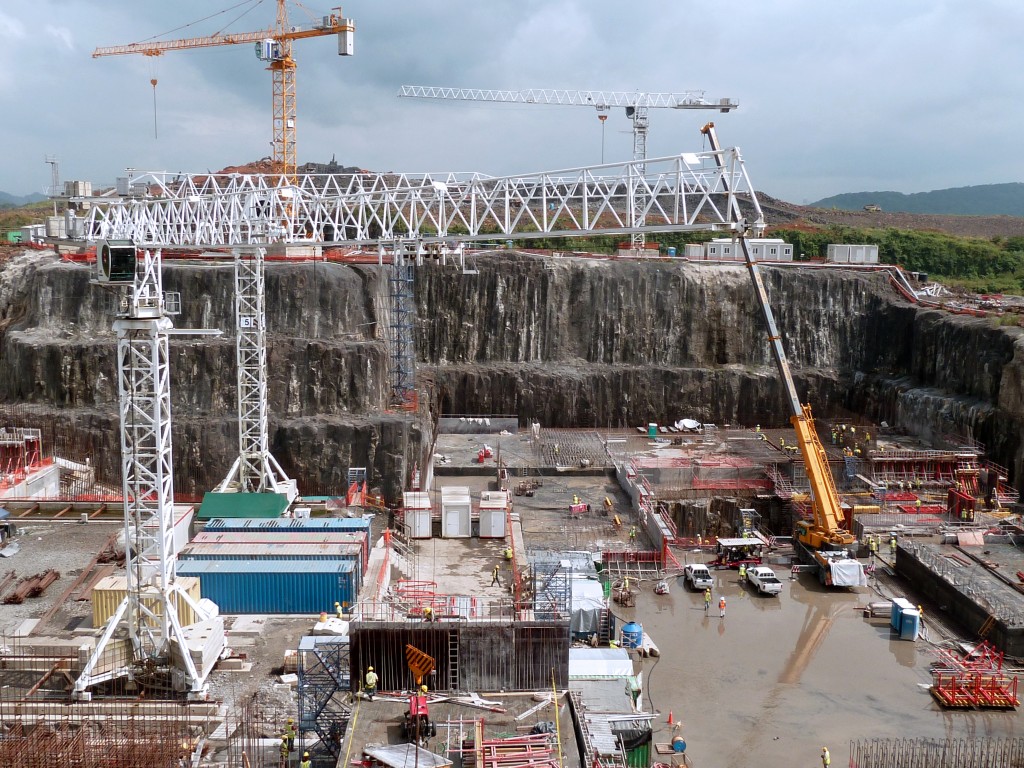
The first PO Orient liner Oriana returns to Southampton after her maiden voyage to the Panama Canal in 1961. She was the largest vessel to pass through the canal since the German liner Bremen in 1939. Photo by Central Press/Getty Images
Considered one of the wonders of the modern world, the Panama Canal opened for business 100 years ago this Friday, linking the Atlantic and Pacific Oceans and providing a new route for international trade and military transport.
At the time it was built, the canal was an engineering marvel, relying on a series of locks that lift ships – and their thousands of pounds of cargo – above mountains.
But thousands of workers died during its construction, and its history has seen no shortage of controversy, including a contentious transference of authority from the US to Panama in the 1970s.
Work recently began on a substantial expansion effort that will allow the canal to accommodate modern cargo needs.
PBS NewsHour recently interviewed several regional experts to discuss the canal’s first 100 years, and to get a sense of what’s ahead.
Ovidio Diaz-Espino grew up in Panama and trained as a lawyer. He is the author of How Wall Street Created a Nation: J.P. Morgan, Teddy Roosevelt, and the Panama Canal.
Richard Feinberg is a professor of International Political Economy at the University of California, San Diego, and a nonresident Senior Fellow with the Latin America Initiative of the Bookings Institution. He served as special assistant to President Clinton and senior director of the National Security Council’s Office of Inter-American Affairs.
Julie Greene is a professor of History at the University of Maryland, specializing in United States labor and working-class history, and co-directs the University’s Center for the History of the New America. She is the author of The Canal Builders: Making America’s Empire at the Panama Canal, and serves as President of the Society for Historians of the Gilded Age and Progressive Era.
Noel Maurer is an associate professor of business administration at Harvard University, and the author of The Big Ditch: How America Took, Built, Ran, and Ultimately Gave Away the Panama Canal.
Orlando Pérez is Associate Dean, School of Humanities Social Sciences at Millersville University in Pennsylvania. He is the author of Political Culture in Panama: Democracy after Invasion, and a member of the Scientific Support Group for the Latin American Public Opinion Project at Vanderbilt University.

Steam shovels load rocks blasted away onto twin tracks that remove the earth from the Panama Canal bed circa 1908. It took the United States 10 years to build the canal at a cost of $375 million (which equals about $8.6 billion today). Photo by Buyenlarge/Getty Images
PBS NewsHour: Why did the U.S. build the Panama Canal?
Richard Feinberg: This is about Teddy Roosevelt, the great nationalist, the imperialist. The canal is built in the early part of the 20th century, right after the US-Spanish war. It was when the US was sowing its oats. They had expanded their power over Puerto Rico, Cuba and the Caribbean, but also the Philippines, so the US is becoming a Pacific power, and the Panama Canal was about linking our growing Pacific power to more traditional Atlantic relationships. It was linked to the idea of the rise of the US as a global power, with both commercial and military potential.
The canal was a geopolitical strategy to make the United States the most powerful nation on earth.Ovidio Diaz-Espino: The US for the first time was going to be able to gain control of both oceans. That was critical in times of war. There was no air power, so the way you fought an enemy was through the sea. World power was consistent with maritime power. Americans knew they needed this to move ships from east to west quickly. If they did that, they would control power because they would control the oceans. The Canal was a geopolitical strategy to make the United States the most powerful nation on earth.
Also, the economic impact was massive. Now you could unite the trade between the two oceans. Starting in the 1890s, and until WWI, global trade was just as significant as it is now, so it was important to have a commute route across the continent. This is why Wall Street was very supportive and helped fund it.
The US wanted to frame a vision of itself as more selfless, more a help to the world, more advancing civilization.Julie Greene: In part, the Canal was central to the US vision of itself as a beneficent power in the world. As the US was emerging as a global power, it was important to distinguish themselves from the old powers of Europe, which they saw as more crassly seeking power and control and colonialism. The US wanted to frame a vision of itself as more selfless, more a help to the world, more advancing civilization. Of course there’s the other side to that: often the US was, despite its self-image, imposing its power. In Panama, it asserted its power over the republic and dominated the county’s history for 100 years. But nonetheless the canal has remained central to American national identity, in part because it’s seen to exemplify that beneficent self-image.
The SS Ancon, the first Ship to pass through the Panama Canal on August 15, 1914. Photo by Getty Images
PBS NewsHour: What did it take to get the Panama Canal built? What was the cost of this project?
Julie Greene: It was in incredible project, the largest public construction project in US history. The engineering, technical, medical, and scientific challenges were incredible, first having to get disease under control and then figure out whether it should be a sea-level or a lock canal. It was 40 miles long and literally cut through the continental divide, so it was extremely difficult.
Orlando Pérez: The idea of an interoceanic canal dates back to the Spanish colonial period. The French attempted to do this and failed. After that failure, the US came in. The American ingenuity was of building, rather than a sea level canal, a lock canal. The way the terrain is, a sea-level canal would flood, it was prone to landslides and the terrain was not stable enough. You had to accommodate different levels. It was lower on one side than on the other side, with mountains in between. The systems of locks is what made it possible.
When it rained, the dirt would turn to puddles, which attracted mosquitos, which meant malaria rips through your workforce.Noel Maurer: A key thing the US did, was they used railroads to truck out the dirt. The French were piling it up, which led to landslides. Also, when it rained, the dirt would turn to puddles, which attracted mosquitos, which meant malaria rips through your workforce. The US established medical innovations to control malaria and yellow fever.
Ovidio Diaz-Espino: The construction itself was so significant that at one point one-third of the city of Pittsburgh was working to build the canal. Every lock of the canal, and there are four, has more steel, more concrete, and took more work than the Empire State Building. Something like six Empire State Building constructions are here. There was massive steel, provided by US Steel. Massive concrete provided by Portland Cement. GE had to invent new type of machineries to be able to move the ships, these huge tankards that only had a few inches on either side needed to be controlled. Railroad had to be developed with minute precision. Dredging techniques used to dredge the Port of New York had to be much more precise.
With such a massive body of work it probably employed one-third of Central America and the Caribbean, and the US was heavily influenced by it and by the money that was flowing through Wall Street, the banks, the insurance companies.
Richard Feinberg: Congress was raising questions of, “Do we need this, is it worth it?” So in 1906 when it was under construction, Teddy Roosevelt travelled down, the first time a sitting US president ever left the continental United States while in office. He staged a successful PR stunt: he sat in a big earth moving machine wearing a Panama hat, made a speech that America could and needed to do this, and when he returned to the US the Senate supported its construction.
Julie Greene: But on top of that had to do with the human challenges involved. The chief engineer said at one point that the real challenge of this canal, and what allowed the US to succeed, was in figuring out how to manage and discipline the humans. “That was my contribution,” he said. By that, he meant they had to build a whole society: a police force, dorms, cafeterias, a judicial system. Forty-five thousand women and men, mostly men, came from dozens of different countries, and then thousands of women and children came to be with their menfolk. To create a world for them and then to keep it orderly was a challenge.
PBS NewsHour: What was the human toll?
Julie Greene: The United States built the Canal between 1904 and 1914, picking up the ball from the disastrous efforts by the French. The loss of life during the French era was much greater because disease was more widespread. The US managed to get yellow fever completely under control, and malaria largely under control. By the official US statistics, the mortality rate was about 10,000 people, maybe a little less. But it’s hard to gauge: one historian who looked more closely argued that the death rate was probably 15,000 – or 1/10 of all men who worked on the project.
27,000 people died building the Panama Canal during those two periods. Can you imagine an infrastructure project today that cost 27,000 lives?Richard Feinberg: Panama had not existed before this. There were some independence movements which the US decided to support, creating a new country in order to construct this canal. So Panamanians who welcomed independence welcomed the canal. But the canal was built mostly by foreign workers. They imported tens of thousands of Caribbean workers, many of whom died from disease or accidents.
Ovidio Diaz-Espino: 27,000 people died building the Panama Canal during those two periods. Can you imagine an infrastructure project today that cost 27,000 lives?
PBS NewsHour: What were some of the controversies surrounding its construction? How was it seen on the ground in Panama and by its neighbors?
Julie Greene: The chief engineer had extensive powers thanks to an executive order. Anyone in the Canal Zone not productive could be deported. Many were. Workers who refused to show up would be, if not deported, sentenced to jail time. They had a massive police force, and did not allow strikes. Workers who might try to organize could be and were quickly deported. In the end, this kind of careful system of rules and regulations allowed order.
The US relied on a vast system of racial and ethnic segregation, the Gold and Silver Rolls. American, white workers were paid in gold, and they had better housing and conditions. Most workers of African descent in the Caribbean were on “silver rolls.” They lived in hovels and ate outside or under porches during the torrential rainfalls. It’s not surprising they’d rely on segregation, but the demographics of the Canal Zone weren’t black and white. Thousands of Spaniards came in and found that they were referred to as the “semi-white Europeans,” and excluded from the white hotels and cafeterias. They were pretty ticked off, and built up a vast network of anarchist politics and would go on strike even though they weren’t allowed to. So the US found it constantly had to manage problems resulting from its own policies.
Noel Maurer: Bringing in all these black laborers created a bit of a stink in Panama, and contributed to racial tensions that lasted a long time. A big chunk of the country today is descended from those workers, creating tensions.
Beginning in 1999, the effect for Panama has been massive. It was as if we suddenly discovered oil, except it’s a more stable commodity than oil.Orlando Pérez: For Panamanian nationals at the time, this was the accomplishment of their dreams, to position Panama at the heart of a global commercial enterprise or system, to use the geographic location of Panama to its commercial advantage. Geography has always determined Panamanian politics and the economy. The problem was how that accomplishment came about, which was essentially by subordinating a chunk of their territory to an extraterritorial power, through a treaty that no Panamanians signed. The payment [to Panamanians] was substantial, but it wasn’t anywhere near the benefits that the US would accrue. So the Panamanians started with the great hope that it would place Panama at the center of world commerce, but also resenting that they achieved this victory at the cost of ceding sovereignty over the Canal itself.
PBS NewsHour: In 1977, President Carter signed a treaty with General Omar Torrijos, then Commander of the Panamanian National Guard, ceding control of the Canal to Panama beginning in 1999. What impact did this shift in authority have?
Ovidio Diaz-Espino: The Canal was administered exclusively by Americans for the interest of American military and geopolitical concerns. Panamanians felt they were not benefitting from the canal. And there was a fence. As a child growing up, I could not go into the Canal Zone because I was Panamanian. It was pure American land. This was the most valuable piece of land in the country, and it was being exploited by somebody else. There was a lot of conflict leading to massacres, students killed by soldiers because they tried to raise a Panamanian flag at the Canal. It was an unstable situation.
Richard Feinberg: I wasn’t in the Clinton administration during the handover but I was part of the negotiations leading up to it, and I was also in the Carter administration for the treaty. The treaty was a huge political debate. Reagan enhanced his reputation as a strong nationalist by opposing the treaties, and it cost Carter dearly, in terms of creating a narrative that he was somehow retreating from American power abroad, which was later compounded by crises in Iran and elsewhere. But it was extremely important for relations with Panama and Latin America.
Noel Maurer: By the time the treaty came along, the US benefits from the Canal were almost gone. This wasn’t charity, it wasn’t Carter being nice to the Latin Americans. This was strategy. By the 1970s, American farmers shipping food to Asia could railroad to Seattle and ship from there because railroad costs was much cheaper post-WWII. Militarily, the Canal turned out to be strategically useless, and totally indefensible. Truman tried to hand it over the UN. It was losing money under Johnson. The only reason for the political opposition to the Carter treaties was that it was a symbol of American national pride, especially after Vietnam.
Ovidio Diaz-Espino: The political consequence in Panama was felt immediately. Within two years, the Canal Zone came down. The Americans were still managing it, and the military bases were still here, so the security was still in the hands of the Americans, but it was now Panamanian land. That defused a lot of tensions not just in Panama but throughout Latin America, as it had been the poster child of American colonialism in Latin America.
The Panamanians have done a marvelous job at running it. It’s efficient and profitable.Orlando Pérez: The Panamanians have done a marvelous job at running it. It’s efficient and profitable. It’s run independent of the Panamanian government. There have been very few reported or alleged cases of corruption within management. It’s a very efficient, moneymaking enterprise, and I think everyone that looks at how Panamanians have handled the management, creating an authority for it, they wish the national government was run as efficiently and effectively as that.
Ovidio Diaz-Espino: Beginning in 1999, the effect for Panama has been massive. It was as if we suddenly discovered oil, except it’s a more stable commodity than oil, and it will become even more stable as there is more dependence on the Canal as a result of the expected growth in global trade between Asia and America. And it’s not just the revenues, but everything around it: 3 major ports creating thousands of jobs. A whole industry devoted to shipping services as a result. Sixty percent of all world cargo has a Panamanian flag. There’s a burgeoning residential market in the former Canal Zone, and a huge part around the canal is this untouched rainforest, a watershed, so it’s becoming is a hotbed of ecotourism. Now they’re planning for cruise ships to drop off in Panama City. This is all because of the canal.
And there’s something more important, which I call the peace element. The canal gives us something no neighbor has, and that’s political stability. The neutrality clause in the Torrijos-Carter treaty says that the US has the right to intervene in Panamanian internal affairs if the security of the canal is ever threatened. Why is there no corruption, why does the canal operate with the precision of a Swiss watch factory? Because Americans always have their eyes on it. You know it’s not going to be ruined.

Construction underway on new locks in the Panama Canal in 2011. Photo by Juan Jose Rodriguez/AFP/Getty Images
PBS NewsHour: Expansion of the Panama Canal is due to begin soon. What should we know about this project?
Richard Feinberg: It’s a modernization. As container ships have gotten bigger and bigger, the canal needs to be larger. There’s no doubt that commercially the expansion is important and it will pay off over time with the increased traffic that will result, as more and bigger ships pass through.
Julie Greene: It’s a huge undertaking being run efficiently. It’s behind schedule, but that’s not surprising. What they’re doing is building another set of lock basins, and they’ve designed it in a very green, environmental way. Instead of using fresh water every time the locks have to be filled, because that would have been stressful on water supply, they devised an engineering system that allows them to recycle the water.
There are nonetheless challenges even though green ideals were in mind. For ships to go through quickly, that will put pressure on the Gatun Lake and hurt its environment a bit, so there’s some debating going on as to whether they should slow down the speed to protect the lake.
Orlando Pérez: The expansion project has generated a huge amount of employment, and has been the catalyst for high economic growth. Some Panamanians see a problem with this growth, that it’s not well shared across the nation. Panama is still a dual economy. Economic growth is centered mostly in the urban areas, tied to commercial enterprises, tied to tourism and to the Canal. But if you go to rural areas, poverty is much higher.
Julie Greene: Certainly it’s an important part of the US political economy, and will be more so with the expansion once it’s complete in 2015. In fact lots of changes are happening across the US as different port cities prepare for the larger ships that will be able to come through.
Ovidio Diaz-Espino: The expansion is important for Panama, but it’s much more important for the United States. I can’t imagine how much is being invested in the US. No port was ready to take those ships, so every major port has to expand. So New York, New Jersey, Baltimore, Miami, Galveston, New Orleans, all have to do major dredging. Then you need to expand the highways, and you’ll need more container space locally. The expense is massive, and all are racing to prepare. The delay in finishing the project means the US has more time to get ready.
The other thing is that it is going to change patterns of trade. Right now, most Asia-US trade comes through Long Beach. That will change. Most trade by water will go to southern and northeastern ports. That has implications for railroad companies, truck companies, and entire cities. Joe Biden said this may make inflation go down, which will make the US more competitive in its exports to China.
These interviews have been edited for clarity and brevity.



